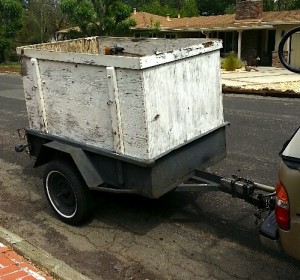 YES I DID. I REALLY DID. I flipped my lid. I was at the dump in Martinez. My trailer has been with me since 1999, when I bought it used but in good shape on Shattuck Avenue in Berkeley as a metal base with wheels only, no sides or top. Over the past 15 years I must have taken one load per month per customer to the dump, sometimes singly, sometimes shared. That’s 180 trips more or less. More importantly, that’s 365 x 15 = 5,475 days in the rain and cold, summer heat and winter wind. In short, the lid was tired, well-worn, sagging in the middle, falling apart from use, covered with chipped and fading white primer paint and light green-yellow lichen, and ready to be tossed. So I tossed it. Flipped it off at the dump. Loosened its hinges, its hasps, its supporting post in the front section and gave it a Heave-Ho.
YES I DID. I REALLY DID. I flipped my lid. I was at the dump in Martinez. My trailer has been with me since 1999, when I bought it used but in good shape on Shattuck Avenue in Berkeley as a metal base with wheels only, no sides or top. Over the past 15 years I must have taken one load per month per customer to the dump, sometimes singly, sometimes shared. That’s 180 trips more or less. More importantly, that’s 365 x 15 = 5,475 days in the rain and cold, summer heat and winter wind. In short, the lid was tired, well-worn, sagging in the middle, falling apart from use, covered with chipped and fading white primer paint and light green-yellow lichen, and ready to be tossed. So I tossed it. Flipped it off at the dump. Loosened its hinges, its hasps, its supporting post in the front section and gave it a Heave-Ho.
‘Slugging rats at the dump’
It’s something my Dad always talked about, even when we were kids in the early 1950s in San Leandro. He and his older brother, our Uncle Paul, always talked about going to the dump and “slugging rats.” I wasn’t sure what that meant, but we rarely went to the dump with Uncle Paul in San Leandro, and we never “slugged rats.”
Later as an adult I once asked Dad, had he and Uncle Paul actually “slugged rats” at the dump? “No,” he said, it was just an adventurous phrase that two boys growing up in Oakland’s cherry orchards in the 1930s might have said quite regularly. But it stuck in our family’s vocabulary forever.
But do I need a trailer?
As a homeowner and light-construction guy for the past 50 years, I have always gone to the dump. Recycling is great, and so is taking stuff to Goodwill, but sometimes over is over and junk collects, and it’s DUMP TIME. And I’ve nearly always had a pickup truck since my first one in 1970, and then continuously since 1989. But did I need a trailer too?
I debated long and hard, and in 1999 when I was in Berkeley for other business I saw this small trailer in a retiring blacksmith’s shop. It contained his scrap heap of old metal but it was on wheels. He was emptying years of rusted scrap metal from it and carried a sign on it: FOR SALE for something like $250. What a gem! But did I need it?
 By now I was a root-removing sewer cleaner for Drain Patrol of Concord, my well-paying corporate career was long gone and well over, and my truck was full of tools. Could I add sides and a top to the trailer and carry my three sewer-cleaning rotary cables in it? Roll them up an extended back tailgate? Increase my efficiency and therefore my income potential on the job? What about towing? Licensing? Where would I store it? I wasn’t ready, so I said no to all options and went home.
By now I was a root-removing sewer cleaner for Drain Patrol of Concord, my well-paying corporate career was long gone and well over, and my truck was full of tools. Could I add sides and a top to the trailer and carry my three sewer-cleaning rotary cables in it? Roll them up an extended back tailgate? Increase my efficiency and therefore my income potential on the job? What about towing? Licensing? Where would I store it? I wasn’t ready, so I said no to all options and went home.
But the thought persisted for a week and I drove back to Berkeley. The blacksmith had retired in the meantime, sold his property and moved. Bummer! I asked a nearby shop owner aand found that he lived in El Sobrante. I was off in a flash, directions on a notepad, and called him from a pay phone: Was the trailer still for sale? Yes it was! I would be there within the hour! I bought it, hooked up some temporary trailer connections, and with no existing license plates, I headed for home in Benicia on the back roads. Yeehaw! I had a trailer!
My UC design professors would be proud
I checked out the wiring to the taillights, added a functional hitch and electrical connection to my 1989 Toyota, 4WD, 5-speed white pickup truck, and set about to build the ideal trash-hauler. It was 3/4-inch exterior grade plywood with 2x4s in the vertical support slots and a back tailgate-ramp, but the top was special: a bifolding top that allowed me to have a flat, enclosed load — but folding it once forward and then again upward, and supported by a side-mounted, hinged support pole, allowed me total inside access for loading and unloading. My UC-Berkeley mechanical engineering design professors would be proud as punch! Volume of the insides: 44 inches wide x 46 inches deep x 70 1/2 inches long making it a 3-cubic-yard trailer if you do the math. Galvanized hinges and hasps and thumb releases, and a coat of white primer paint allowed me to call DMV in Vallejo and arrange an appointment to get a Trailer Vehicle Identification Number and a real trailer license plate.
Califoria Gov. Gray Davis in later years created some kind of TPI, Trailer Permanent Identification, sticker and fee to eliminate yearly expenses for trailer license renewals. Except once when apparently state income needed to be boosted and I received some cockamamie letter in the mail for a one-time additional fee! Right and whatever.
New top to come or not?
Maybe yes, maybe no. All loads have to be covered to enter most dumps to avoid littering and subsequent fines, and maybe a blue tarp and rope over it may look a little too hokey, so I suspect this summer I’ll rebuild a new top and give it a new coat of primer. Finish paint? Maybe, maybe not. It’s a work in progress, just like its owner.
Peter Bray lives, works and writes in Benicia.






Leave a Reply